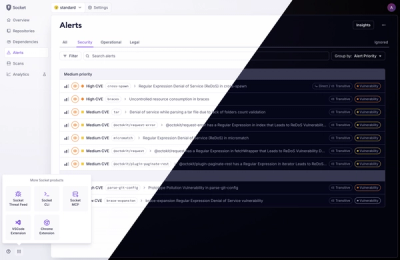
Product
A Fresh Look for the Socket Dashboard
We’ve redesigned the Socket dashboard with simpler navigation, less visual clutter, and a cleaner UI that highlights what really matters.
@react-querybuilder/dnd
Advanced tools
Augments react-querybuilder with drag-and-drop functionality.
To see this in action, check out the react-querybuilder demo with the drag-and-drop option enabled.
npm i --save react-querybuilder @react-querybuilder/dnd react-dnd react-dnd-html5-backend
# OR
yarn add react-querybuilder @react-querybuilder/dnd react-dnd react-dnd-html5-backend
To enable the drag-and-drop functionality of a query builder, wrap the <QueryBuilder /> element in <QueryBuilderDnD /> and pass in the exports from react-dnd and react-dnd-html5-backend as props to QueryBuilderDnD.
import { QueryBuilderDnD } from '@react-querybuilder/dnd';
import * as ReactDnD from 'react-dnd';
import * as ReactDndHtml5Backend from 'react-dnd-html5-backend';
import { QueryBuilder, RuleGroupType } from 'react-querybuilder';
const fields = [
{ name: 'firstName', label: 'First Name' },
{ name: 'lastName', label: 'Last Name' },
];
const App = () => {
const [query, setQuery] = useState<RuleGroupType>({ combinator: 'and', rules: [] });
return (
<QueryBuilderDnD dnd={{ ...ReactDnD, ...ReactDndHtml5Backend }}>
<QueryBuilder fields={fields} query={query} onQueryChange={q => setQuery(q)} />
</QueryBuilderDnD>
);
};
While not strictly necessary, we strongly recommend passing the react-dnd and react-dnd-html5-backend exports in as props to <QueryBuilderDnD />. If they are not passed in as props, the initial render of the query builder will have drag-and-drop disabled until the dependencies are asynchronously loaded via import().
<QueryBuilderDnD /> will automatically set the enableDragAndDrop prop to true on any descendant <QueryBuilder /> elements unless enableDragAndDrop is explicitly set to false on the <QueryBuilder /> element.
<QueryBuilderDnD /> does not need to be an immediate ancestor to <QueryBuilder />.
Multiple <QueryBuilder />s may be nested beneath a single <QueryBuilderDnD />. The same drag-and-drop settings will be applied to each of them.
If your application already uses react-dnd outside the scope of a query builder, use QueryBuilderDndWithoutProvider instead of QueryBuilderDnD to inherit context from your existing <DndProvider />. Example:
import { QueryBuilderDndWithoutProvider } from '@react-querybuilder/dnd';
import { DndProvider } from 'react-dnd';
import { HTML5Backend } from 'react-dnd-html5-backend';
import { QueryBuilder, RuleGroupType } from 'react-querybuilder';
import { SomeOtherDndContextConsumer } from './SomeOtherDndContextConsumer';
const fields = [
{ name: 'firstName', label: 'First Name' },
{ name: 'lastName', label: 'Last Name' },
];
const ChildComponentOfDndProvider = () => {
const [query, setQuery] = useState<RuleGroupType>({ combinator: 'and', rules: [] });
return (
<QueryBuilderDndWithoutProvider>
<QueryBuilder fields={fields} query={query} onQueryChange={q => setQuery(q)} />
</QueryBuilderDndWithoutProvider>
);
};
const App = () => {
return (
<DndProvider backend={HTML5Backend}>
<SomeOtherDndContextConsumer />
<ChildComponentOfDndProvider />
</DndProvider>
);
};
[v6.0.0] - 2023-02-18
ValueEditor update--including the ValueEditors in the compatibility packages--for "between"/"notBetween" operators. When the operator for a rule is "between" or "notBetween", two inputs will be displayed. Each will have the class "rule-value-list-item". They will manage the value as a comma-separated list unless listsAsArrays is true, in which case a proper array will be used.$rqb-border-radius) is now 0.25rem (previously 4px). Visually, this should be the same for most users since 16px is the default font-size on most browsers, and $16 \times 0.25 = 4$.c has been removed. Use a package like clsx (what RQB uses internally) instead.is-small class, so they will be rendered at their default size."exports" field in their package.json for better ESM compatibility.ValueEditor prop selectorComponent (optional) enables the replacement of only the selector component in the value editor without recreating the logic in the default value editor. E.g., const MyValueEditor = (props: ValueEditorProps) => (<ValueEditor {...props} selectorComponent={MyValueSelector} />) will use the default value editor logic and presentation except when it would normally display the default ValueSelector.@react-querybuilder/native and associated example showcasing multiple UI libraries.useQueryBuilder: All logic and configuration formerly internal to the QueryBuilder component has been extracted into a custom Hook, making it easy to implement one's own presentation layer without reproducing or copy-pasting the official component code.useRuleGroup: As useQueryBuilder is to the QueryBuilder component, the useRuleGroup Hook is to the RuleGroup component.useRule: As useRuleGroup is to the RuleGroup component, the useRule Hook is to the Rule component.RuleGroupHeaderComponents/RuleGroupBodyComponents: These JSX fragments have been extracted from the RuleGroup component and exposed as named exports, enabling the creation of a custom RuleGroup wrapper without recreating the "innards" of the default RuleGroup. (For example, the new @react-querybuilder/native package wraps these fragments in View elements from react-native).ValueEditors new behavior for "between"/"notBetween" operators.
QueryBuilder prop getValueEditorSeparator: Takes a field name and an operator name and should return a ReactNode (string, element, etc.) that will be placed between the two editors when operator is "between" or "notBetween". E.g., getValueEditorSeparator={() => "and"}.QueryBuilder prop parseNumbers: When true, the default ValueEditor will update its rule with an actual number instead of the string representation whenever possible.ValueEditor prop skipHook: When true, the useValueEditor hook call within the default ValueEditor component will not make query updates. Enables safer rendering of the default ValueEditor as a fallback to a custom value editor.useValueEditor hook now returns an object with valueAsArray and multiValueHandler properties. See ValueEditor code for usage.regenerateIDs works for any object, not just rule groups.add, remove, update, and move) will fail gracefully and return the original query if the provided path or parentPath points to an invalid location in the query hierarchy.formatQuery option quoteFieldNamesWith now accepts an array of strings with two elements. The first element will precede each field name and the second will succeed each field name. E.g., ['[', ']'] would result in `[Field name] ...`.FAQs
Drag-and-drop-enabled version of react-querybuilder
The npm package @react-querybuilder/dnd receives a total of 14,863 weekly downloads. As such, @react-querybuilder/dnd popularity was classified as popular.
We found that @react-querybuilder/dnd demonstrated a healthy version release cadence and project activity because the last version was released less than a year ago. It has 1 open source maintainer collaborating on the project.
Did you know?

Socket for GitHub automatically highlights issues in each pull request and monitors the health of all your open source dependencies. Discover the contents of your packages and block harmful activity before you install or update your dependencies.

Product
We’ve redesigned the Socket dashboard with simpler navigation, less visual clutter, and a cleaner UI that highlights what really matters.

Industry Insights
Terry O’Daniel, Head of Security at Amplitude, shares insights on building high-impact security teams, aligning with engineering, and why AI gives defenders a fighting chance.

Security News
MCP spec updated with structured tool output, stronger OAuth 2.1 security, resource indicators, and protocol cleanups for safer, more reliable AI workflows.